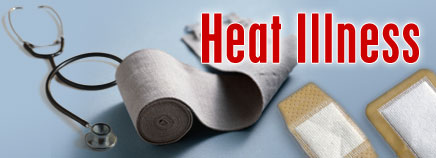
Our bodies create a tremendous amount of heat. Normally, they’re cooled through sweating and by heat radiating through the skin.
But in very hot weather, high humidity, and other conditions, this natural cooling system may begin to fail, letting heat in the body build to dangerous levels. The can cause heat illness, such as heat cramps, heat exhaustion, or heatstroke.
Heat Cramps
Heat cramps are brief, painful muscle cramps in the legs, arms, or abdomen that may occur during or after vigorous exercise in extreme heat. The sweating that occurs with intense physical activity causes the body to lose salts and fluids. This low level of salts causes the muscles to cramp.
Kids are particularly at risk for heat cramps when they aren’t drinking enough fluids.
Although painful, heat cramps on their own aren’t serious. But cramps can be the first sign of more serious heat illness, so they should be treated right away to help avoid any problems.
What to Do:
A cool place, rest, and fluids should ease a child’s discomfort. If possible, give fluids that contain salt and sugar, such as sports drinks. Gently stretching and massaging cramped muscles also may help.
Heat Exhaustion
Heat exhaustion is a more severe heat illness that can occur when someone in a hot climate or environment hasn’t been drinking enough fluids. Symptoms can include:
- increased thirst
- weakness
- fainting
- muscle cramps
- nausea and/or vomiting
- irritability
- headache
- increase sweating
- cool, clammy skin
- elevation of body temperature, but less than 104°F (40°C)
What to Do:
- Bring your child to a cooler place indoors, an air-conditioned car, or shady area.
- Remove your child’s excess clothing.
- Encourage your child to drink cool fluids containing salt and sugar, such as sports drinks.
- Put a cool, wet cloth or cool water on your child’s skin.
- Call your doctor for advice. If your child is too exhausted or ill to drink, treatment with intravenous (IV) fluids may be necessary.
If left untreated, heat exhaustion can develop into heatstroke, which can be fatal.
Heatstroke
The most severe form of heat illness is heatstroke. Heatstroke is a life-threatening medical emergency.
In heatstroke, the body cannot regulate its own temperature. Body temperature can soar to 106°F (41.1°C) or even higher, leading to brain damage or even death if it isn’t quickly treated. Prompt medical treatment is required to bring the body temperature under control.
Factors that increase the risk for heatstroke include overdressing and extreme physical activity in hot weather with inadequate fluid intake.
Heatstroke also can happen when a child is left in, or becomes accidentally trapped in, a car on a hot day. When the outside temperature is 93°F (33.9°C), the temperature inside a car can reach 125°F (51.7°C) in just 20 minutes, quickly raising body temperature to dangerous levels.
What to Do:
Call for emergency medical help if your child has been outside in extreme temperatures or another hot environment and shows one or more of these symptoms of heatstroke:
- severe headache
- weakness, dizziness
- confusion
- nausea
- rapid breathing and heartbeat
- loss of consciousness
- seizure
- no sweating
- flushed, hot, dry skin
- temperature of 104°F (40°C) or higher
While waiting for help:
- Get your child indoors or into the shade.
- Undress your child and sponge or douse him or her with cool water.
- Do not give fluids unless your child is awake, alert, and acting normally.
An Ounce of Prevention
To help protect kids from heat illness:
- Teach kids to always drink plenty of fluids before and during activity in hot, sunny weather — even if they’re not thirsty.
- Make sure kids wear light-colored, loose clothing and use sunscreen when outdoors.
- On hot or humid days, make sure your kids only participate in heavy activity outdoors before noon and after 6 p.m.
- Teach kids to come indoors, rest, and hydrate immediately whenever they feel overheated.

